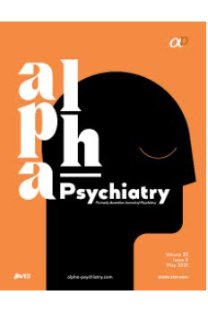Eşcinsellik tutum ölçeği geliştirilmesi, geçerlilik ve güvenilirlik çalışması: Bir ön çalışma
Tutum, Eşcinsellik, Cinsel davranış, Sonuçların tekrarlanabilirliği
Development and reliability study of homosexuality attitudes scale: A preliminary study
Attitude, Homosexuality, Sexual Behavior, Reproducibility of Results,
___
- 1. Sakallı-Uğurlu N, Uğurlu O. Eşcinsellik ve eşcinselliğe ilişkin tutumlar: Önyargı ve ayrımcılık. Kaos GL Lezbiyen ve Geylerin Sorunları 2003 Sempozyum Kitabı, Ankara, Ayrıntı Basımevi, 2004, s.51-63.
- 2. Sakalli N. The relationship between sexism and attitudes toward homosexuality in a sample of Turkish college students. J Homosexuality 2002; 42:51-52.
- 3. Duyan V, Gelbal S. Lezbiyen ve Geylere Yönelik Tutum Ölçeği (LGYT): Güvenirlik ve geçerlik çalışması. HIV/AIDS Dergisi 2004; 7:106-112.
- 4. Igartua KJ, Gill K, Montoro R. Internalized homophobia: a factor in depression, anxiety, and suicide in the gay and lesbian population. Can J Ment Health 2003; 22:15-30.
- 5. Maurice WL. Sexual medicine in primary care. St. Louis, Mosby, 1998, s.117-124.
- 6. Hon KL, Leung TF, Yau AP, Wu SM, Wan M, Chan HY, et al. A survey of attitudes toward Homosexuality in Hong Kong Chinese Medical Student. Teach Learn Med 2005; 17:344-348.
- 7. Herek GM, Capitano JP. Some of my best friends: Intergroup contact, stigma, and heterosexuals’ attitudes toward gay men and lesbians. Pers Soc Psychol Bull 1996; 22: 412-424.
- 8. Herek GM. The psychology of sexual prejudice. Current Dimensions in Psychological Science 2000; 9:19-27.
- 9. Herek GM. Beyond “homophobia”: A social psychological perspective on attitudes toward lesbians and gay men. DeCecco (ed.),Homophobia in American Society, New York, Harrington Park Press, 1985.
- 10. Klamen DR, Grossman LS, Kopacz DR. Medical student homophobia. J Homosexuality 1999; 37:53-63.
- 11. Larsen KS, Reed M, Hoffman S. Attitudes of heterosexuals toward homosexuality: A Likerttype scale and construct validity. J Sex Res 1980; 16:245-257.
- 12. Lena SM, Wiebe T, Ingram S, Jabbour M. Pediatric residents’ knowledge, perceptions, and attitudes towards homosexuality oriented youth. Annals RCPSC 2002; 35:401-405.
- 13. Newman B. The relative importance of gender role attitudes to male and female attitudes toward lesbians. Sex Roles 1989; 21:451-465.
- 14. Sakalli N. Application of the attribution-value model of prejudice to homosexuality. J Soc Psychol 2002; 142:264-271.
- 15. Sakallı N, Uğurlu O. Effects of social contact with homosexuals on heterosexual university students’ attitudes toward homosexuality. J Homosexuality 2001; 42:52-63.
- 16. Sakalli N, Ugurlu O. The effects of social contact with a lesbian person on the attitude change toward homosexuality in Turkey. J Homosexuality 2002; 44:111-119.
- 17. Tekin H. Eğitimde Ölçme ve Değerlendirme. Ankara, 1991.
- 18. Tezbaşaran AA. Likert Tipi Ölçek Geliştirme Kılavuzu. Ankara, Özyurt Matbaası, 1996.
- ISSN: 1302-6631
- Yayın Aralığı: 6
- Başlangıç: 2000
- Yayıncı: -
İnterferon alfa kullanan malign melanomlu bir hastada ortaya çıkan mani: Olgu sunumu
Nazmiye KAYA, İsmet Esra ZEYTİNCİ, MİNE ŞAHİNGÖZ
Kanser hastalarında majör depresyon yaygınlığı ve ilişkili etkenler
Gül TOKGÖZ, İrem YALUĞ, SAMURAY ÖZDEMİR, AYTEN YAZICI, Kazım UYGUN, Tamer AKER
Hatice ÇELİKEL, LÜTFULLAH BEŞİROĞLU
Çocuk ve ergenlerde majör depresif bozukluk: Bir gözden geçirme
Şahin BODUR, Özden Şükran ÜNERİ
Diyarbakır kent merkezinde sigara içme durumu ve ilişkili bazı etkenler
Aziz YAŞAN, Faruk GÜRGEN, Mustafa ÖZKAN, Remzi OTO
Eşcinsellik tutum ölçeği geliştirilmesi, geçerlilik ve güvenilirlik çalışması: Bir ön çalışma
Sultan DOĞAN, Mehmet DOĞAN, Emre BEŞTEPE, Engin EKER
Ruhsal hastalığa yönelik inançlar ölçeği’nin geçerliliği ve güvenilirliği
Ayşegül BİLGE, MAHİRE OLCAY ÇAM
